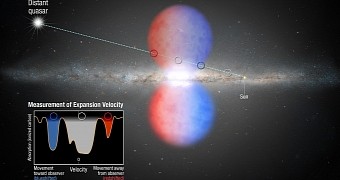In a new paper in The Astrophysical Journal Letters, scientists with the Space Telescope Science Institute in Maryland, US, describe two mammoth gas bubbles that are now rushing out of our home galaxy, the Milky Way, at warp speed.
The gas bubbles, shown in the image accompanying this article, are believed to have formed in the aftermath of a massive eruption that occurred at the core of the Milky Way some 2 million years ago.
Despite having been aware of the existence of these clouds for 5 years now, researchers are yet to figure out how they came into being. Some point the finger at a sudden burst of star formation, whereas others believe that they were birthed by the black hole at the center of our galaxy.
Zooming in on the bubbles' anatomy and makeup
As noticeable in the image made available by Space Telescope Science Institute astronomers, these massive gas clouds towering above and below the plane of the Milky Way are shaped like two lobes. Besides, they are fairly symmetric as far as their shape is concerned.
It is estimated that the two clouds each measure an impressive 30,000 light-years in height. A significant amount of the gas that comprises them is currently moving in the direction of our planet. The remaining gas is moving away from us.
Scientists say that, having taken the time to research these lobe-like formations with the help of the Hubble Space Telescope, they found that these outflowing clouds are moving at a speed of about 2 million miles per hour (3 million kilometers per hour).
Evidence indicates that the bubbles contain more than just gas, although this is their chief ingredient. Thus, astronomers say that elements such as silicon, carbon and aluminum are also included in their makeup. This find supports the theory that the clouds are the byproduct of star formation processes.
It is estimated that the gas in these clouds has a temperature of about 18 million degrees Fahrenheit (about 10 million degrees Celsius). What's interesting is that, while rushing through space, the clouds are collecting even more gas and material from their surroundings.
“We are seeing cooler gas, perhaps interstellar gas in our galaxy's disk, being swept up into that hot outflow,” study leader Andrew Fox of the Space Telescope Science Institute in Baltimore, Maryland, told the press in an interview.
Studying these giant gas clouds is no easy task
The Space Telescope Science Institute astronomers who worked on this research project explain that, to make observations concerning the anatomy of these gas clouds, they looked at how ultraviolet light originating from a distant quasar behind the northern bubble behaves when passing through them.
Thus, by studying how the lobes affect the behavior of this ultraviolet light, they were able to determine the speed, the makeup and the temperature of the gas forming the two bubbles, the researchers explain in The Astrophysical Journal Letters.
As already mentioned, the scientific community has been aware of the existence of these clouds for about 5 years now. The formations were first documented with the help of NASA's Fermi Gamma-ray Space Telescope, hence the fact that they are now referred to as Fermi Bubbles.
Scientists hope that, soon enough, they will be able to determine not just the clouds' speed and size, but also their weight. They also expect that, at some point in the not-too-distant future, they will manage to determine exactly how and why the bubble formed.

 14 DAY TRIAL //
14 DAY TRIAL //